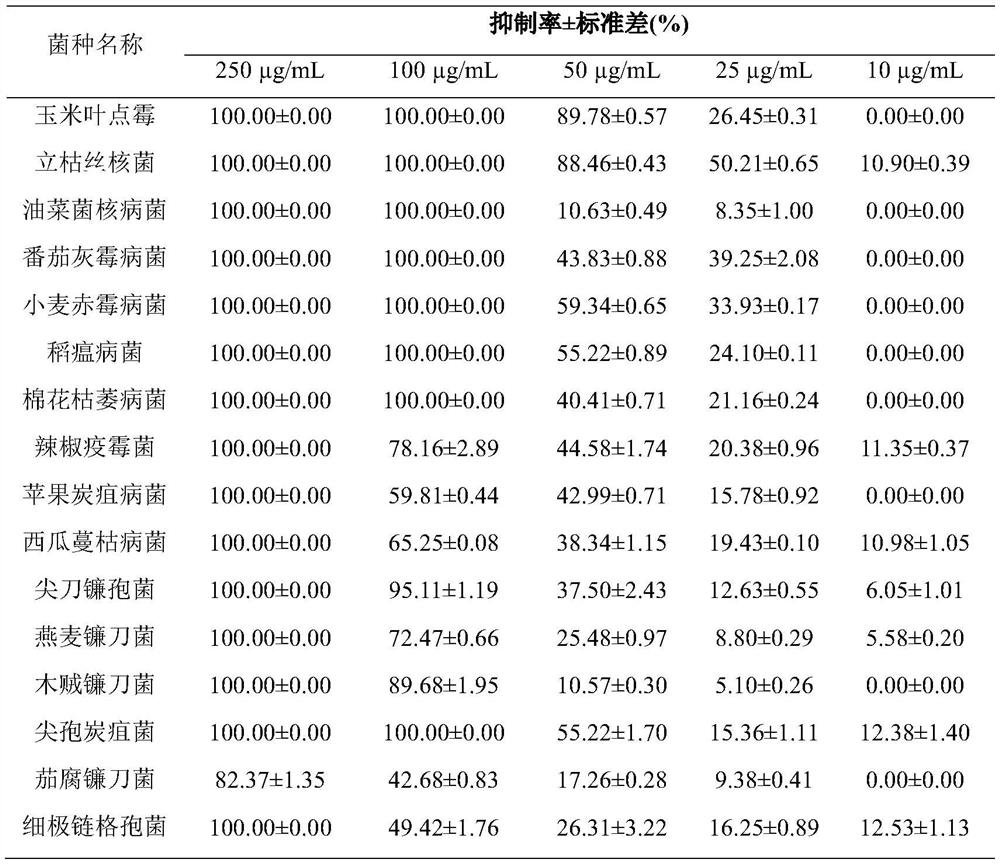Application of origanum vulgare essential oil in prevention and treatment of botanical pathogens
A technology for plant diseases and Sclerotinia sclerotiorum, applied in the fields of application, plant growth regulators, botanical equipment and methods, etc., can solve problems such as soil pollution, chemical residues, and economic losses of farmers, and achieve high bactericidal activity and strong inhibition The effect of broad-spectrum bactericidal effect
- Summary
- Abstract
- Description
- Claims
- Application Information
AI Technical Summary
Problems solved by technology
Method used
Image
Examples
Embodiment 1
[0011] Embodiment 1: oregano essential oil is extracted by steam distillation. Take 40g of sample powder and place it in a 1000mL round bottom flask, add 400mL of distilled water, add zeolite, connect the volatile oil extractor, heat, keep a slight boil (control the electric heating mantle voltage around 100 V), distill for 6h until the amount of volatile oil does not increase any more , The volatile oil was extracted several times with distilled diethyl ether. Take the upper oil phase and place it in a stoppered test tube, dry it over anhydrous sodium sulfate, filter, transfer the filtrate into a concentrating bottle, and concentrate it by atmospheric distillation until there is no ether smell to obtain a volatile oil, which is set aside.
Embodiment 2
[0012] Embodiment 2: Determination of indoor antibacterial activity of phytopathogenic fungi and results
[0013] The phytopathogenic fungi used in this experiment were strains preserved at 4°C in the laboratory. Mycelia growth method was adopted. The medium used for all phytopathogenic fungi in the laboratory except Aspergillus flavus was potato agar dextrose medium (referred to as PDA). PDA medium formula: potato (peeled) 200g, glucose 20g, agar 15g, distilled water 1000mL, natural pH.
[0014] Preparation method of PDA medium: Wash and peel the potatoes, weigh 200g and cut into small pieces, add water and boil until rotten (boil for 20-30 minutes, it can be pierced by a glass rod), filter with four layers of gauze and fill the water in a beaker To 1000mL, add 15-20g of agar according to the needs of the experiment, add 20g of glucose, stir to make it fully dissolved, then divide into Erlenmeyer flasks, sterilize at 121°C for 20 minutes, and cool down for later use.
[0015...
Embodiment 3
[0027] Embodiment 3: Determination of indoor antibacterial activity of plant pathogenic bacteria and results
[0028] The phytopathogenic bacteria used in this experiment were stored at -80°C in the laboratory, and the MIC value was determined by the double dilution method. The phytopathogenic bacteria used in the laboratory all use nutrient broth medium (referred to as MH). MH medium formula: MH broth powder 21g, distilled water 1000mL, natural pH.
[0029] MH medium preparation formula: Weigh 21g of MH broth powder into 1000mL of distilled water, stir to dissolve it fully, then divide it into Erlenmeyer flasks, sterilize at 121°C for 20 minutes, and cool down for later use.
[0030] 1) Use the double dilution method.
[0031] 1. Add 100 μL of MH broth medium to each well of a 96-well plate.
[0032] 2. Add 100 μL of the prepared drug solution to the first well of the three rows A / B / C, and then dilute the drug twice. That is, after adding the drug solution to the first we...
PUM
 Login to View More
Login to View More Abstract
Description
Claims
Application Information
 Login to View More
Login to View More - R&D
- Intellectual Property
- Life Sciences
- Materials
- Tech Scout
- Unparalleled Data Quality
- Higher Quality Content
- 60% Fewer Hallucinations
Browse by: Latest US Patents, China's latest patents, Technical Efficacy Thesaurus, Application Domain, Technology Topic, Popular Technical Reports.
© 2025 PatSnap. All rights reserved.Legal|Privacy policy|Modern Slavery Act Transparency Statement|Sitemap|About US| Contact US: help@patsnap.com


